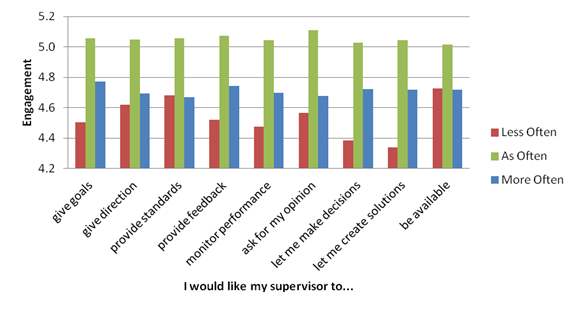In the classic children’s tale The Story of the Three Bears, Goldilocks stumbles upon an empty home where three bears reside.
She finds that each bear has its own preference for porridge, chairs, and beds. After testing each of these, she determines that two of them are always too much in one extreme (e.g., too hot, too soft); however, one is always just right.
Our researchers are currently identifying the just right leadership style for various situations. More specifically, we are examining how specific leadership styles affect employee engagement, and how this relationship may vary depending on the industry and team composition. Thus far, nearly 1,500 employees have answered surveys about their preferences for leadership styles, as well as their current level of engagement with their jobs, supervisors, teams, and organizations. Across all career fields at all levels, our analyses find that employees are most engaged when their leaders consistently perform the following behaviors well:
- Give performance-based goals
- Give direction for completing tasks
- Give standards/examples to judge performance
- Give feedback about performance
- Monitor performance
- Welcome and ask for employees’ opinions
- Expect employees to make decisions and create solutions
- Are available for questions
However, just like in The Story of the Three Bears, these behaviors can be taken to extremes, causing disengagement. The graph below depicts whether employees wanted their supervisors to perform certain behaviors less often, as often, or more often, along with average level of engagement (scale of 1 to 6, with higher values reflecting greater engagement).
The Micromanagement Leadership Style
We’ve found that employees are less engaged at work when their leaders adopt a micromanagement leadership style. These leaders tend to excessively observe, monitor, and provide feedback about performance. In other words, they have an extreme need for control and prefer to make decisions without considering, or even asking for, the input of their direct reports. Leaders with a micromanagement leadership style may be viewed as bossy and controlling by their employees.
The Hands-Off Leadership Style
Where leaders with a micromanagement leadership style provide too much feedback, leaders with a hands-off leadership style provide little, if any, guidance to their employees. Such a leadership style is also associated with less engaged employees. These leaders tend to give employees complete freedom and autonomy to make their own decisions and define their own work goals—which many employees are uncomfortable doing. Leaders with a hands-off leadership style may be viewed as lazy and unmotivated by their employees. In some extreme situations, employees may feel that they are the ones actually performing their leader’s duties.
The Just-Right Leadership Style
Employees who did not want their supervisors to change their behaviors were the most engaged at work. In essence, these leaders are able to strike the proper balance: They offer guidance to their subordinates, but also allow for their input. While these leaders may have the final say when making a decision or planning others’ work, they take into account their employees’ input. Last, these leaders encourage and reward employees who make decisions and create solutions.
Indeed, leaders need to adopt just-right leadership styles to effectively engage their employees. However, the just-right balance between the two extreme styles (micromanagement and hands-off) may vary for each of the leader’s employees. For example, one employee may prefer a leader with a more of a micromanagement style, while another employee may prefer a leader with more of a hands-off style.
As we continue to collect data, we will be able to examine these ideas. We anticipate that leaders who have the most engaged employees are able to adapt their management style to the needs and preferences of each of their employees.
What are your thoughts or stories around these leadership styles and employee engagement?










